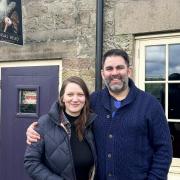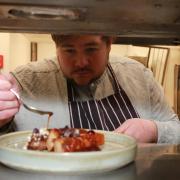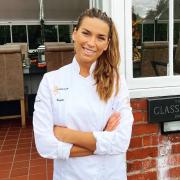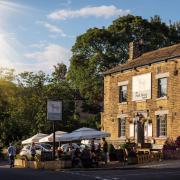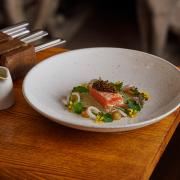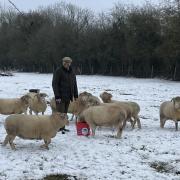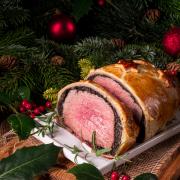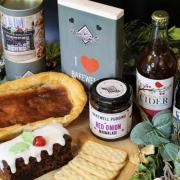As Peak Ales enters the world of gin with its signature Chatsworth Gin – classic with a twist – Penelope Baddeley talks to producer Robert Evans

When the 12th Duke of Devonshire enquired whether anyone on his 25,000-acre estate was producing gin, a small business just a country mile away from Chatsworth House saw an opportunity and stepped in.
Two years on, Peak Ales, which already supplies Chatsworth, its farm shop and the Devonshire Arms inns in Beeley and Pilsley with its national award-winning craft beers, has launched the first Chatsworth Gin.
The producer of this keenly-awaited small batch artisan spirit is 57-year-old Robert Evans, who runs Peak Ales with his wife Debra and a staff of nine based at his two sites: a flagship Brewery Visitor Centre on the Chatsworth Estate close to Bakewell, and a purpose-built brewery at Ashford-in-the-Water.
I met Robert at the neatly-appointed visitor centre just weeks before the official launch of Chatsworth Gin, at Chatsworth Country Fair, following which Robert was due to lunch with the Duke and Duchess, who have fully supported the development of this new craft spirit.

The Brewery Visitor Centre is a beautiful and fitting setting for a business intent on supplying high quality produce with a local provenance. The gravel crunches satisfyingly as you drive up to the large renovated 19th-century barn, which houses a micro-brewery, shop and tasting room - as well as the new boutique distillery.
Robert, who set up Peak Ales in 2005 and has spent the last two years developing Chatsworth Gin, seems understandably anxious and was eagerly anticipating the forthcoming launch.
'This is a very exciting time, we think we have created something that is fantastic and which has an excellent blend of flavours, but until it's out there it's still nerve-racking.'
He ushers me in and smiles when he sees my reaction to his latest big investment - the incredibly beautiful piece of German engineering that is the gin still. Named 'Isobel' by the team, on the inside it's a 'magic' chamber that converts raw grain spirit, ethanol, into gin, via a re-distillation process with beautiful botanicals which characterise and distinguish the gin. On the outside, it reflects light which dances from its bright and gleaming copper surfaces like the portent of a bright future.

'Your reaction to the still is exactly what we want to see from people as they come and visit,' says Robert, who aims to develop gin tours in tandem with the existing brewery tours.
'It's a thing of beauty and I hope people will be able to see that we have put great care and thought into making our artisan product. It's not a soulless industrial plant. We are making a small-batch product here.'
At the time of my visit there had been a first run through of production and the gin is in the tank awaiting bottling. Each batch will number 80 to 85 bottles maximum and will take a day to complete.
This gin-appreciative journalist was eager yet unable to sample the product but took succour from hearing that the first six bottles were to go to Lord Burlington, son of the Duke and Duchess, who had bid for them at the Derbyshire Charity Clay Shoot in 2018 and was patiently waiting for them.

The new venture is a timely investment for Peak Ales, coinciding with the rapid rise in popularity of British gin. Craft gin makers sprang up nationwide after London gin producer Sipsmiths won a two year battle with HMRC in 2009 for the right to produce gin in small quantities rather than on an industrial scale. The number of small gin producers has doubled in the ten year period following the relaxation in licensing laws benefiting boutique distilleries.
Robert said: 'This is a new string to our bow. Gin is such a popular drink and growing in popularity. We will look to produce a portfolio of gins in the future but our number one priority is to make Chatsworth Gin as the estate would want it.'
Peak Ales has liaised closely with the Duke and Duchess of Devonshire in the development of the new artisanal gin, sending them samples of all four experimental small-scale distillations undertaken. Each of these used select botanicals sourced from the grounds and greenhouses of the Chatsworth Estate, as well as those traditionally used. The Devonshires' opinion was considered alongside guidance from industry consultant Jamie Baxter, who is an influential figure behind the new gin trend.
The resulting product is a classic London dry gin whose botanic ingredients include Chatsworth Estate lemon verbena, lemongrass and lemons, which add a bright and refreshing note to the drink.

'We are working with Chatsworth Head Gardener Steve Porter to ensure we have a steady supply of these botanicals, but what is extra special is that we are also using banana leaf from the Cavendish bananas and that, I think, is unique.'
The fascinating story of the history of the Cavendish banana is cited on a tag attached to each bottle. Most commercially sold bananas today are descended from a single banana plant brought to Chatsworth from Mauritius in 1830 for cultivation by the 6th Duke of Devonshire's famous head gardener Joseph Paxton. He named the specimen Musa Cavendishii after his employer William George Spencer Cavendish. In the 1950s after Panama disease devastated banana plantations in South and Central America, the Cavendish fruit was introduced there and today all export bananas and almost half of all the bananas grown worldwide are descended from the Cavendish cultivar.
'Our gin is going to be distinctive and unique,' says Robert. 'It's a classic London dry gin with botanicals leaning towards a citrus taste but nicely balanced by the herbal quality of the banana leaf.'
After detailed research Rob decided upon an 'all-rounder' bottle with distinctive labelling. The back label, seen through the bottle, features an archive photograph of Chatsworth House and at the front is a motif of a stag's head and a coronet - insignia of the Cavendish family, which Peak Ales is delighted to have been given permission to use.
Peak Ales' strong association with Chatsworth began in 2003, when Robert and his wife Debra decided to sell their house, uproot their young family, leave secure jobs and re-locate from Worcester to set up their micro-brewery in a barn on the Chatsworth Estate.
'We were both approaching 40 years old and had to make a decision as to what we wanted to do for the rest of our lives.'
Robert, who originally trained as a PE teacher in Liverpool, had been working in the field of cardiac rehabilitation as a hospital-based exercise physiologist in Dudley. He had always had a passion for craft beer and researched its potential as a career, taking courses in the field and working in a small brewery.
'I had always felt cask ales were a fantastic part of English heritage and that we should trumpet that. I had identified that the Peak District would be well served by a micro-brewery and had knowledge of the area as my family was from Chesterfield.'
He approached Chatsworth, as the biggest land owner in the area, to enquire after premises and was shown the large derelict barn. 'Doors and windows were hanging off, there was grass and brambles in the courtyard but you could see the potential.'
With the help of a Rural Enterprise Grant and match funding from Chatsworth, Robert and Debra, also a former teacher, began extensive renovations.
After overcoming planning consent hurdles, delays with grant committee decisions and problems with resident barn owls they finally moved onto the site to push their project forward. It took two years before the family business produced its first beer in the barn, which now has its own bespoke barn owl box.
'It was so frustrating,' Robert remembers. 'The delays meant all my contingency funds disappeared and I had to dip into supply teaching to help keep us going and Debra went to work at Lady Manners School. It was a very stressful period and felt like a huge risk we were undertaking.'
'But we were fortunate and are still fortunate that we have always had excellent support from Chatsworth and the estate farm shop, the two Devonshire Arms inns in Pilsley and Beeley, the estate club and the house which provided a nucleus of customers.'
The first cask ales produced by the business were Bakewell Best, so named to exploit a growing trend for local provenance, and Swift Nick, named after a historic highwayman who was thought to have robbed locals on their return from Bakewell market.
Peak Ales went on to develop its most popular beer Chatsworth Gold, which is characterised by its use of honey from the hives on the Chatsworth Estate and was inspired by chef patron Alan Hill at the Devonshire Arms inn at Beeley, who suggested that Peak Ales make a beer that identified Chatsworth itself. Today some 7,000 pints of Chatsworth Gold are consumed each week locally.
The business benefited from being one of the first of its kind to set up in Derbyshire and it did so at the beginning of a revival of interest in cask-conditioned beer, the driving force of which was the introduction of a European-style system of a progressive beer duty brought in by Gordon Brown in 2002, that meant small brewers could pay a lower level of tax.
By 2012 the business was going so well it had hit capacity, producing 35-40 barrels a week in its ten-barrel plant, and in October 2014 Peak Ales moved into new units at Ashford-in-the-Water, where they installed a new 20-barrel plant, doubling the size of their original operation.
Robert admits it remains a huge source of pride for him to see his pump clips on bars across the county. He said: 'We have had super support from local landlords.'
In 2017 the barn was transformed into a flagship brewery visitor centre with the aid of the Rural Development Programme for England (RDPE) and funding from the European Agricultural Fund for Rural Development, and with a brief to create an environment comparable to other tourist destinations associated with Chatsworth. In addition to the new gin distillery there's a 2.5-barrel pilot brewery which is used to experiment with new beer recipes, as well as the tasting room and shop.
'We are in a tourist area and people want to taste and appreciate the local produce and we reinforce that. Visitors can drink and take away a product and the gin is a super new product to sell and another reason for people to come and visit us.'
Robert declares that he wouldn't have been able to move into the gin market without the support of his staff, who have taken on responsibility for the brewery while he's been consumed by the new project. He's already thinking ahead about new gin lines and styles. 'It will be a real tick in the box when it's all out there. And then I think I'll really need to relax with a gin!'
Chatsworth Gin can be purchased from the Peak Ales Visitor Centre and Chatsworth Estate Farm Shop, retailing at just under £40.






